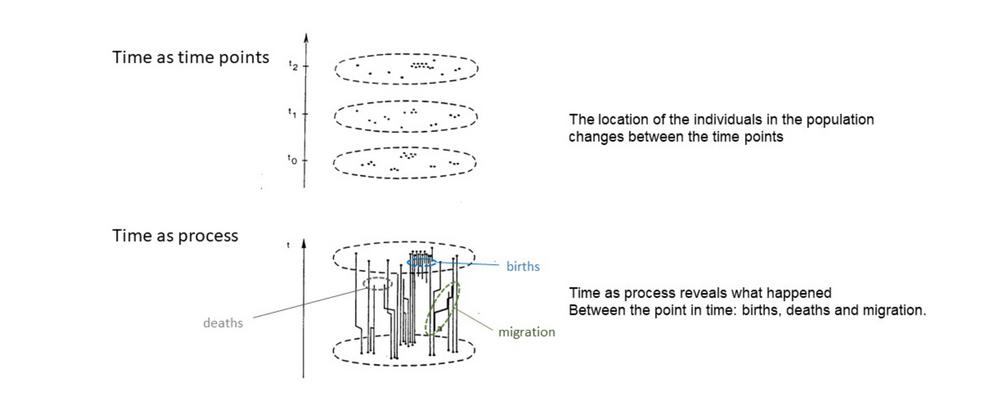
Biography of Torsten Hägerstrand
Torsten Hägerstrand (1916-2004) was Professor in Human Geography at Lund University, Sweden, between 1957 and 1982. He is the father of chorological innovation theory (early 1950´s), migration chain thinking (late 1950´s and early 1960´s) and the time-geographic approach (late 1960´s and onwards).
Torsten Hägerstrand was a modern scientist with integration of knowledge from various scientific fields as a lead thought. He argued that geographers should contribute to make the Earth a sustainable home for its various populations and to help understanding not only the promises from new technologies, but also their threats – e.g. on resources and life forms. He put to the fore that human industrial activities affect land, water and the life of many species, and exemplified with chemical substances that can be found not only where they are intended to be, but also in many other places and parts of ecosystems where they are not supposed to be. He claimed that: “It is more and more clear that mankind has become a geological agent.” (Hägerstrand 1993b, p. 161). Hägerstrand stressed the importance of the material aspects of the real world as the base for life and with an imperative for researchers to take some basic constraints into consideration: that natural resources, time and space are limited – just like the individuals’ life. He pointed out that a weakness with non-materially grounded thinking about problems in the real world may lead to decisions that do not enough consider factors that are taken for granted and therefore left out. He stated: “… that it is very easy to dream up blue-prints for new undertakings but very hard to imagine their fate and their consequences for other legitimate processes when put into practice. Perhaps the trouble is that thought does not encounter in its own world the constraints of space and time.” (Hägerstrand, 1976, p. 334). Hence, he opposed the translation of natural and other resources into economic values as a single base for decision, since then the material substance of a resource and the distance between the geographical location of its origin and the location of its use were hidden.
Nevertheless, Torsten Hägerstrand was not a hard core materialist. His materialism is embedded in a deep concern for the importance of human experiences, reflections and reasoning for the development of geographical knowledge.
Torsten Hägerstrand’s writings have influenced the scientific community from the late 1950’s and onwards. His publications cluster into three main research themes: Innovation; Migration; and Activity, travel and space (time-geography). However, Hägerstrand´s influence is not limited to scientific endeavors. His way of analyzing, his methods and the results of his research had a substantial impact on Swedish societal planning. He actively engaged in the public investigations on, for example, transport planning, urban planning, planning of healthcare location and future research. The width and depth of Hägerstrand´s work point at a normative mission for scientists from natural, social and technical sciences to learn from each other, cooperate and develop integrated approaches in order to create opportunities for a sustainable use of our common world (Hägerstrand and Lenntorp, 1974; Hägerstrand and Lenntorp, 1993). The combination and integration of ecological, economic and social aspects – including studies of behavior based on habits – provide a deeper understanding of the interrelations influencing life in the landscape. In his ecological approach, he defined the problem concerning how to understand the contexts of the human world (Hägerstrand, 1977). He argued for a broader definition of the concept of ecology than the merely biological one dominating at that time. He acknowledged the biological approach, but wanted to include the human influence and highlighted the motives for the human projects and people’s daily activities (Hägerstrand, 1977; 1993a).
Further readings and references
Hägerstrand, Torsten, 1970; What about People in Regional Science (1970) Regional Science Association Papers, Vol. XXIV: 7-21.
Hägerstrand, Torsten and Bo Lenntorp, 1974; Samhällsorganisation i tidsgeografiskt perspektiv. Statens Offentliga Utredningar 1974:2: 221-232, bilaga 2
Hägerstrand, Torsten, 1976; Geography and the Study of Interaction between Nature and Society. Geoforum, Vol 7:329-344.
Hägerstrand, Torsten, 1977; Att skapa sammanhang i människans värld - forskningens bidrag. Kungl vitterhets-, historie- och antikvitetsakademien. Konferenser 1. Almqvist & Wiksell, Stockholm, pp 188-192.
Hägerstrand, Torsten, 1993a; Samhälle och natur. Lunds universitets geografiska institutioner. Rapporter och Notiser, No. 11
Hägerstrand, Torsten, 1993b; What about nature in regional science? In Visions and strategies in European integration: a North European perspective. L. Lundqvist and L.O. Persson (eds). Berlin, Germany: Springer-Verlag, pp. 155–161.
Hägerstrand, Torsten and Bo Lenntorp, 1993; Region och miljö - sammanfattning av ett projekt om ekologiska perspektiv på den rumsliga närings-och bosättningsstrukturen. NordREFO 1993:5. pp 229-237
Hägerstrand, Torsten, 2006; “Foreword.” In By Northern Lights: On the Making of Geography in Sweden. Edited by A. Buttimer and T. Mels, xi–xiv. Ashgate Publishing Group.
Ellegård, Kajsa, 2018; Thinking Time Geography. Concepts, Methods and Applications. Routledge Studies in Human Geography.
Ellegård, Kajsa and Uno Svedin, 2012; Torsten Hägerstrand’s time-geography as the cradle of the activity approach in transport geography. Journal of Transport Geography, 23, 17-25.